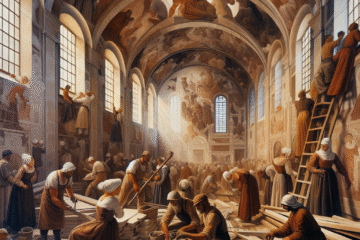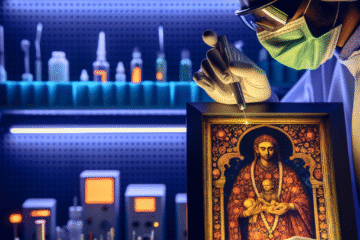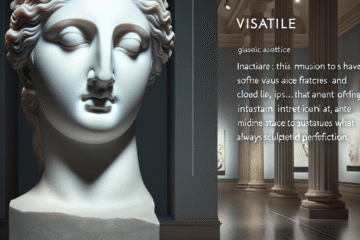I. Introduction
Art and war are two concepts that have been intertwined throughout history. From ancient cave paintings depicting battles to modern day photographs capturing the devastation of conflict, art has long been used to both reflect and respond to war. The relationship between art and war is complex and multifaceted, and studying this relationship can provide valuable insight into the human experience of conflict.
Throughout history, artists have used their work to express their thoughts and feelings about war. In some cases, war has inspired artists to create powerful works that reflect the realities of the conflict. For example, the Spanish artist Francisco Goya created a series of prints called “The Disasters of War” that depicted the atrocities committed during the Peninsular War between Spain and France. In other cases, artists have used their work to question or critique the motivations behind a particular war. For example, the American artist Jasper Johns created a series of paintings in the 1960s that used images of the American flag to comment on the Vietnam War.
However, the relationship between art and war is not always one of reflection or criticism. In some cases, governments and militaries have used art as a tool of propaganda during times of war. For example, during World War II, both the Axis and Allied powers produced a vast amount of propaganda art to encourage support for the war effort. These works often used powerful images and slogans to promote a particular message or ideology.
Studying the impact of conflict on artistic expression is important for several reasons. Firstly, it allows us to gain a deeper understanding of the human experience of war. By analyzing artworks produced during times of conflict, we can gain insight into the thoughts, feelings, and experiences of those who lived through those times. Secondly, studying the relationship between art and war can help us to better understand the role of art in society. Art is not just a form of entertainment or decoration – it can also be a powerful tool for social and political commentary. Finally, understanding the impact of conflict on artistic expression can help us to appreciate the resilience and creativity of artists who are able to continue working in the face of adversity.
In the following sections of this article, we will explore the different ways in which war has impacted artistic expression throughout history. We will discuss the themes and motifs commonly found in art produced during times of conflict, the use of art as propaganda during war, and the impact of war on artistic communities. Through this exploration, we hope to gain a deeper understanding of the complex relationship between art and war.
II. Artistic Expression in Times of War
Artistic expression during times of war has often served as a powerful tool for capturing the realities of conflict and reflecting on its impact on society. From depictions of battlefield scenes to commentary on the broader social and political implications of war, artists have created works that offer unique perspectives on the human experience of conflict.
One of the most powerful examples of wartime art is Pablo Picasso’s “Guernica,” which was created in response to the bombing of the Spanish town of Guernica during the Spanish Civil War. The painting, which depicts the horrors of war through a series of powerful symbols and images, has become an iconic representation of the devastation and brutality of conflict. Similarly, Francisco Goya’s “The Third of May 1808” is a powerful representation of the violence and brutality of war, depicting the execution of Spanish citizens by French soldiers during the Peninsular War.
The themes and motifs found in art produced during times of war often reflect the experiences and observations of the artists themselves. For example, many works produced during World War I reflected the disillusionment and despair that many people felt in the wake of the conflict. Paintings such as John Singer Sargent’s “Gassed” and Otto Dix’s “Der Krieg” depict the physical and emotional toll of war on soldiers and civilians alike.
Another common theme in wartime art is the concept of sacrifice and heroism. Many works produced during times of conflict depict soldiers as brave and selfless figures, sacrificing themselves for the greater good of their country. For example, Jacques-Louis David’s “The Oath of the Horatii” depicts a scene from Roman history in which three brothers swear to fight to the death for their country. The painting has been interpreted as a powerful symbol of the sacrifices that soldiers make in times of war.
In addition to reflecting on the realities of conflict, many artists have used their work to express their political views and question the motivations behind a particular war. For example, the American artist Jasper Johns created a series of paintings in the 1960s that used images of the American flag to comment on the Vietnam War. Similarly, the German artist Käthe Kollwitz created a series of prints in the early 20th century that criticized the political and social conditions that led to World War I.
In conclusion, artistic expression during times of war has played a critical role in capturing the realities of conflict and reflecting on its impact on society. Through their work, artists have offered unique perspectives on the human experience of war, highlighting themes such as sacrifice, heroism, and the devastating toll of conflict. As we continue to grapple with the ongoing impact of war on our world, the power of artistic expression to inspire empathy, reflection, and understanding remains as important as ever.
III. Art as Propaganda
Art as propaganda is a powerful tool that has been used by governments and militaries throughout history to influence public opinion and promote a particular message or ideology. During times of war, propaganda art has played a crucial role in shaping public perception of the conflict, mobilizing support for the war effort, and demonizing the enemy. In this section, we will explore the history of propaganda art, provide examples of wartime propaganda art, and analyze the messages and symbolism used in these works.
Governments and militaries have long recognized the power of art as a tool for propaganda. In ancient times, rulers used art and architecture to promote their power and authority, while in more recent times, propaganda art has been used to promote nationalistic, ideological, or political objectives. During World War I, governments and militaries produced a large volume of propaganda art, ranging from posters to cartoons to films. Propaganda art was also widely used during World War II, and during the Cold War, both the United States and the Soviet Union used propaganda art to promote their respective ideologies.
One of the most famous examples of propaganda art is the Soviet poster “Workers of the World, Unite!” created by Dmitry Moor in 1919. The poster depicts a muscular worker breaking chains, with the slogan “Proletarians of All Countries, Unite!” written in bold letters. The message of the poster was clear – to promote the idea of a worldwide socialist revolution and encourage workers to unite against their oppressors.
Similarly, during World War II, the United States produced a large number of propaganda posters that promoted patriotism and support for the war effort. One such poster, created by J. Howard Miller in 1943, features a woman in a blue work shirt with the slogan “We Can Do It!” written above her. The poster was designed to motivate female workers to enter the workforce and support the war effort.
Propaganda art often relies on powerful symbolism and images to promote its message. For example, in Nazi Germany, propaganda art often depicted the Aryan race as strong, heroic figures, while Jews and other minorities were depicted as weak and dangerous. The use of such symbolism was intended to promote the Nazi ideology of racial superiority and justify the persecution of Jews and other minority groups.
In conclusion, propaganda art has played a critical role in shaping public opinion during times of war. Through its use of powerful symbolism and imagery, propaganda art promotes a particular message or ideology and mobilizes support for the war effort. As we continue to grapple with the ongoing impact of war on our world, the study of propaganda art offers valuable insight into the complex relationship between art and politics.
IV. The Impact of War on Artistic Communities
The impact of war on artistic communities is significant and far-reaching. Wars disrupt the cultural fabric of society, and the loss of life and destruction of property can have a profound effect on the artists and their creative output. In this section, we will explore the effects of war on artistic communities, provide examples of how specific conflicts have impacted artists and their work, and analyze how artists respond to the trauma and disruption of war through their work.
Wars can disrupt artistic communities in several ways. Firstly, wars can lead to the displacement of artists, causing them to flee their homes and seek refuge in other countries. This can have a significant impact on their careers and creative output. Secondly, wars can cause the destruction of cultural institutions and infrastructure, including museums, galleries, and studios, which can have a profound impact on the ability of artists to create and display their work. Finally, wars can cause psychological trauma, affecting the mental health and well-being of artists.
One of the most significant impacts of war on artistic communities was the effect of World War I on the Dada movement. The Dadaists were a group of artists who rejected traditional art forms and embraced an anti-art aesthetic. The trauma and devastation of World War I had a profound impact on the Dada movement, and many of its members were driven to create works that reflected their disillusionment and despair. The work of Dada artists such as Marcel Duchamp and Hannah Höch was characterized by its irreverence, humor, and rejection of traditional artistic norms.
The Vietnam War had a significant impact on American artists, with many using their work to comment on the conflict and its social and political implications. The war was highly controversial, and many artists saw it as a symbol of the failure of American society. The work of artists such as Robert Rauschenberg and Bruce Nauman reflected the trauma and disruption of the conflict, with works that addressed themes such as violence, alienation, and political corruption.
The impact of war on artists is not always negative. Many artists have responded to the trauma and disruption of war by creating powerful works that reflect their experiences and offer insight into the human experience of conflict. For example, the American painter Edward Hopper created a series of works during World War II that depicted the loneliness and isolation of American life during the war. Similarly, the British artist Henry Moore created a series of sculptures in response to the devastation of the Blitz, which reflected the resilience and fortitude of the human spirit.
In conclusion, the impact of war on artistic communities is complex and multifaceted. Wars can disrupt the cultural fabric of society, and the loss of life and destruction of property can have a profound effect on artists and their creative output. However, many artists have responded to the trauma and disruption of war by creating works that reflect their experiences and offer insight into the human experience of conflict. Through their work, artists have provided a powerful commentary on the impact of war on society and the human psyche.
V. Conclusion
Art and war are two concepts that have been intertwined throughout history. From reflecting the realities of conflict to serving as a tool of propaganda, artistic expression has played a critical role in shaping public opinion during times of war. In this article, we have explored the impact of conflict on artistic expression, the use of art as propaganda during times of war, and the effects of war on artistic communities.
Through our exploration, we have seen how wars can inspire artists to create works that reflect their experiences and observations, as well as how governments and militaries have historically used art as a tool of propaganda during times of conflict. We have also seen how wars can disrupt artistic communities and affect the careers and lives of individual artists, but how artists have responded to the trauma and disruption of war through their work.
The relationship between art and war is complex and multifaceted, and studying this relationship can provide valuable insight into the human experience of conflict. By analyzing artworks produced during times of war, we can gain insight into the thoughts, feelings, and experiences of those who lived through those times. We can also better understand the role of art in society, as a powerful tool for social and political commentary.
In conclusion, the study of the relationship between art and war is important, especially in times of conflict. This knowledge can be used to promote peace and understanding by providing insight into the experiences and perspectives of those affected by war. By studying the role of art in times of war, we can gain a deeper understanding of the complexities of conflict and the ways in which artists have responded to it. Ultimately, this understanding can help us to appreciate the resilience and creativity of artists who are able to continue working in the face of adversity, and inspire us to work towards a more peaceful future.


